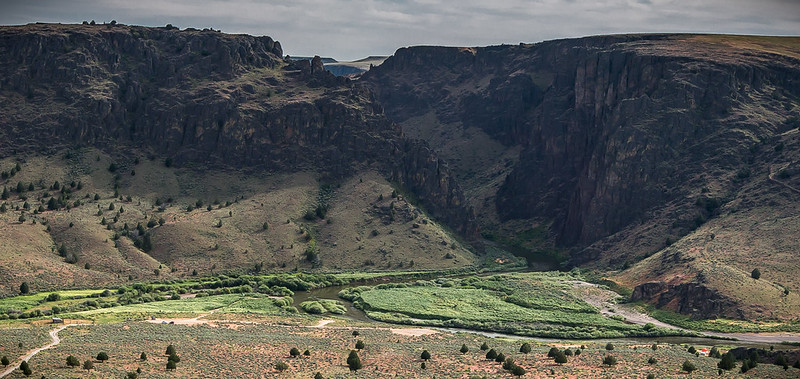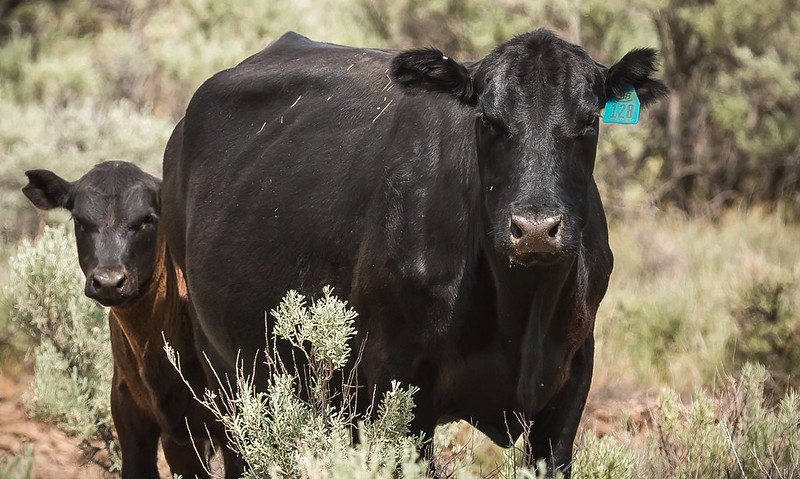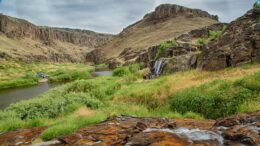Outdoor adventurers visiting Oregon often flock to the rocky coastline, climb snow-capped Mount Hood, or peer into the gleaming blue waters of Crater Lake. But few make it to the Owyhee Canyonlands, in the remote southeast corner of the state. Here millions of acres of desert wilderness stretch into southwestern Idaho and northern Nevada — a sea of sagebrush interrupted by jagged red-rock canyons, clear streams, rollicking whitewater, riverside hot springs and darky, starry night skies.
The Owyhee offers recreation opportunities for bikers, hikers, paddlers, fishers and other travelers. But it’s the area’s conservation potential that has attracted attention recently. It contains a huge expanse of sagebrush steppe, a habit in decline as the desert West has been plowed, paved and grazed. Intact sagebrush steppe is needed by far-ranging animals like pronghorn, elk and bighorn sheep, and the U.S. Fish and Wildlife Service has identified the Owyhee as a priority conservation area for imperiled greater sage grouse. It’s home to some 250 species, including 28 endemic plants and 14 bats — wild, diverse, and largely unprotected.
But that could change.
Wilderness or Monument
Protecting the Owyhee has long been a goal of conservationists, and legislation now in Congress could help — depending on who you ask. The Malheur Community Empowerment for the Owyhee Act would designate 1.1 million acres as wilderness in the Owyhee that’s currently managed by the Bureau of Land Management. It’s supported by Friends of the Owyhee, Oregon Natural Desert Association, the Wilderness Society, Conservation Lands Foundation and other regional and national organizations.
The bill also has the backing of Oregon’s two senators. It was introduced in the summer of 2023 by Sen. Ron Wyden and is cosponsored by Sen. Jeff Merkley. It passed the Senate Committee on Energy and Natural Resources in December with bipartisan support, which is further than previous versions of the bill introduced in years past have made it. But that could be as far as it goes.

“We recognize that we’re in an election year and that the House of Representatives hasn’t been prioritizing conservation legislation,” says Ryan Houston, executive director of Oregon Natural Desert Association. “Actually getting this bill all the way through both houses of Congress and getting it on the president’s desk before the end of this Congress at the end of December are really long odds.”
That’s why supporters are also pursuing another strategy: calling on the Biden administration to designate the area a national monument.
“We know that the Biden administration is interested in monuments and given the groundwork that’s been laid here, we believe this is a good, viable alternative to the legislation if Congress doesn’t act,” he says.
Land designated as “wilderness” comes with protections under the Wilderness Act, which includes closing the area to future mining claims. A monument would come with whatever protections are in the president’s proclamation, which can also include limitations on road building and industrial development.
Preventing any industrialization of the Owyhee would be particularly important.
The sagebrush steppe landscape across the intermountain West is a heavily fragmented type of habitat, which makes large remaining swathes critical for wildlife. “When we have intact areas where wildlife can move across tens of thousands of acres without having to interface with industrial facilities, we can maintain strong wildlife populations, we can maintain good healthy habitat,” says Houston. “But once it gets fragmented, that can have significant impacts on wildlife.”
An uninterrupted landscape will also better help plants and animals cope with climate change as they need to shift their ranges to higher elevations as temperatures warm.
“Species need to be able to move across elevation gradients to be able to accommodate and adapt to a changing environment,” he says. “Having connected habitats across elevational gradients, soil types, geology, moisture and precipitation regimes — all of those kinds of forms of connection are fundamentally what help protect biodiversity on a landscape like this.”
The Grazing Problem
While that’s true, not all environmentalists see the current legislation or national monument effort as the best ways to protect the area’s wildlife and wilderness characteristics. One of those is Katie Fite, director of public lands for Wildlands Defense.
[The legislation] “would be a tragedy for biodiversity and for anyone seeking a real wilderness experience on public lands,” she says. “It’s a ticket for destroying the very wilderness-worthy and monument-worthy values that are out there in the Owyhee landscape.”
At issue is the fact that the vast majority — upwards of 90% — of Oregon’s high desert lands managed by the BLM are used for cattle grazing, and this includes the 1.1 million acres proposed for wilderness designation, says Houston. Grazing can threaten the ecological health of sagebrush steppe landscapes. Cows trample native vegetation, pollute water sources and cause streambank erosion. Under either the wilderness bill or a potential national monument, that grazing is likely to continue. Under the 1964 Wilderness Act existing active grazing permits are allowed to continue.

In the case of a national monument, the president has the choice. “But in this case, based on the other monuments the president has established, based on the politics here, based on who’s around the table, we would fully expect that the president would establish a monument that would allow for the continuance of grazing subject to existing law and regulation,” he says. “It can change in the future because the BLM has the role and the responsibility to manage grazing. So in the future, there could be more, there could be less, it could be different. But a wilderness designation itself isn’t a trigger that changes it.”
While Houston says that “impacts of grazing on that landscape have been significant.” He also sees a path for better management. “In both cases there are ways that management could improve conditions on the landscape,” he says. “The first goal is to protect the habitat, the next to manage for conservation.”
The BLM is charged with managing for multiple uses, which includes goals that are often opposed — like protecting wildlife and managing grazing. Designating land as a monument or wilderness can help narrow the focus, says Houston.
But Fite sees grazing in a wilderness area like the Owyhee as fundamentally problematic.
“I view this as an attack on the Wilderness Act, on wilderness as a whole and on public lands by enshrining grazing,” she says. “It would degrade the very meaning of monument and wilderness.”
And it would greatly imperil the ecosystem the conservation effort seeks to protect, she says.
Grazing can fuel the spread of nonnative invasive plants such as cheatgrass and Medusahead, which are highly flammable, she says. It’s a problem made worse as ranchers haul water into more remote areas for livestock, and further spread invasive plants, which proliferate near water sources in the arid landscape.
“Areas of extensive trampling disturbance around water sources are epicenters for weed infestation,” she says. “They’re hauling the water along these roads and then putting the trough out in the middle of nowhere. Once you get these weeds going out there, there’s really no going back.”
Additional Risks
Besides grazing, other threats loom, such as industrial development and the roads that come with it. That includes mining for minerals such as silver, gold and uranium; oil and gas production; industrial wind and solar development; and the transmission systems that accompany all kinds of energy infrastructure.
Wilderness protections would ward off those advances, but Fite worries that they miss the most at-risk area: the McDermitt caldera, which isn’t included in proposed land for protections in the Owyhee. The Thacker Pass lithium mine has already been permitted on BLM land at the southern edge of the volcanic crater just across the border in Nevada and would be on the Owyhee’s doorstep.
“Oregon senators are totally looking away from the biggest threat out there in this very water-starved landscape, which is lithium mining and uranium mining in the McDermitt Caldera,” she says.
As Houston sees it, wilderness protections aren’t perfect but still a necessary step.
“We care about protecting [the Owyhee landscape], and we care about managing it better. Protecting it is something like wilderness. It shuts down those [development] threats. Period. Done. Permanently,” he says. “Managing it better is about things like grazing and other types of decisions that the BLM makes continuously over time. Fundamentally managing it better is a longer-term conversation.”
But if more protections do come, that would also mean more people. Despite the fact that the Owyhee isn’t a well-known travel destination, it also isn’t undiscovered. Growing Boise sits just an hour to the east, and recreationists of all kinds hike, drive, and fish the Owyhee. More could join them.
“Change is happening regardless of what happens with the designation, so what we need is better management, and we need the BLM to have the resources and the direction from leadership — whether that’s Congress or the president — to manage the recreation well,” says Houston.
There’s one thing that all conservationists are likely to agree on: “It’s a special, majestic landscape, and that’s why fundamentally we’re interested in protecting it,” he says.
If, and how, that gets done remains to be seen.
Previously in The Revelator:
![]()


